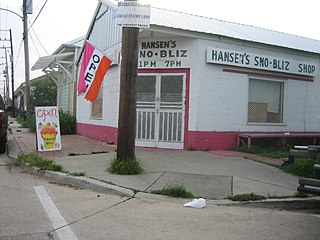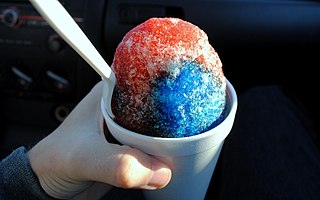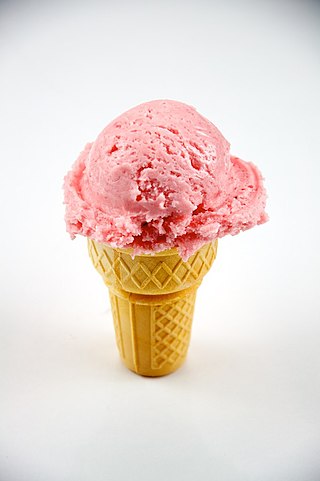
Snow cream can be one of two distinct desserts.

Cream soda is a sweet soft drink. Generally flavored with vanilla and based on the taste of an ice cream float, a wide range of variations can be found worldwide.

Drumstick is the brand name, owned by Froneri, a joint venture between Nestlé and PAI Partners, for a variety of frozen dessert-filled ice cream cones sold in the United States, Australia, Canada, Malaysia, Hong Kong, and other countries around the world. The original product was invented by I.C. Parker of the Drumstick Company of Fort Worth, Texas, in 1928.

A snow cone is a variation of shaved ice or ground-up ice desserts commonly served in paper cones or foam cups. The dessert consists of ice shavings that are topped with flavored sugar syrup.

An ice cream float or ice cream soda, also known as a spider in Australia and New Zealand, is a chilled beverage that consists of ice cream in either a soft drink or a mixture of flavored syrup and carbonated water.

Breyers is a brand of ice cream started in 1866 by William A. Breyer in Philadelphia, Pennsylvania.

Chocolate syrup is a sweet, chocolate-flavored condiment. It is often used as a topping or dessert sauce for various desserts, such as ice cream, or mixed with milk to make chocolate milk or blended with milk and ice cream to make a chocolate milkshake. Chocolate syrup is sold in a variety of consistencies, ranging from a thin liquid that can be drizzled from a bottle to a thick sauce that needs to be spooned onto the dessert item.
A snowball is a ball of snow, usually made by compacting snow with the hands.

Hansen's Sno-Bliz is a snowball stand located in New Orleans, Louisiana, U.S.A., on Tchoupitoulas Street at Bordeaux Street.

The Shamrock Shake is a seasonal green mint flavored milkshake dessert sold at some McDonald's restaurants during March to celebrate St. Patrick's Day in the US, Canada and Ireland.

Shaved ice is a large family of ice-based desserts made of fine shavings of ice or finely crushed ice and sweet condiments or syrups. Usually, the syrup is added after the ice has been frozen and shaved—typically at the point of sale; however, flavoring can also be added before freezing. The dessert is consumed worldwide in various forms and ways. Shaved ice can also be mixed with large quantities of liquid to produce shaved ice drinks.

Shave ice or Hawaiian shave ice is an ice-based dessert made by shaving a block of ice and flavoring it with syrup and other sweet ingredients. On Hawai‘i Island, it is also referred to as "ice shave." In contrast, a snow cone, a similar American dessert, is made with crushed ice rather than shaved ice. The thin ice shavings of shave ice allow for the flavored syrups to be absorbed completely instead of sinking to the bottom. Hawaiian shave ice is derived from a similar ice-based dessert from Japan called kakigōri and thus involves similar production methods.
Drink mixers are the non-alcoholic ingredients in mixed drinks and cocktails. Mixers dilute the drink, lowering the alcohol by volume in the drink. They change, enhance, or add new flavors to a drink. They may make the drink sweeter, more sour, or more savory. Some mixers change the texture or consistency of the drink, making it thicker or more watery. Drink mixers may also be used strictly for decorative purposes by changing the color or appearance of the drink. They also simply increase the volume of a drink, to make it last longer.

Creole cream cheese is a form of farmer cheese that is traditional in the New Orleans area of Louisiana in the United States. It is made from skim milk, buttermilk and rennet, has a mild, slightly tart, slightly sweet taste, and is frequently mixed with cream, sugar and fruit and served as a dessert. It is often used to make Creole cream cheese ice cream.

Blue Sky Beverage Company was a beverage company that produced soft drinks and energy drinks. It is a wholly owned subsidiary of the Monster Beverage Corporation. The company was established in Santa Fe, New Mexico, in 1980, where it remained until it was purchased by Monster in 2000. Coca-Cola North America took ownership of Blue Sky Sodas, Hansen’s Juice Products, Hansen’s Natural Sodas, Hubert’s Lemonade, Peace Tea and other non-energy drink brands as part of Coke’s partnership with Monster Beverage Corp on Jun 12, 2015. Blue Sky Beverage Company now operates out of Corona, California. The southwestern look and feel of the artwork on the soda cans is reminiscent of the company's roots in New Mexico.

A piragua[piˈɾa.ɣwa] is a Puerto Rican shaved ice dessert, shaped like a cone, consisting of shaved ice and covered with fruit-flavored syrup. Piraguas are sold by vendors, known as piragüeros, from small, traditionally brightly-colored pushcarts offering a variety of flavors. Besides Puerto Rico, piraguas can be found in mainland areas of the United States with large Puerto Rican communities, such as New York and Central Florida.

The cuisine of New Orleans encompasses common dishes and foods in New Orleans, Louisiana. It is perhaps the most distinctively recognized regional cuisine in the United States. Some of the dishes originated in New Orleans, while others are common and popular in the city and surrounding areas, such as the Mississippi River Delta and southern Louisiana. The cuisine of New Orleans is heavily influenced by Creole cuisine, Cajun cuisine, and soul food. Seafood also plays a prominent part in the cuisine. Dishes invented in New Orleans include po' boy and muffuletta sandwiches, oysters Rockefeller and oysters Bienville, pompano en papillote, and bananas Foster, among others.

Strawberry ice cream is a flavor of ice cream made with strawberry or strawberry flavoring. It is made by blending in fresh strawberries or strawberry flavoring with the eggs, cream, vanilla, and sugar used to make ice cream. Most strawberry ice cream is colored pink or light red. Strawberry ice cream dates back at least to 1813, when it was served at the second inauguration of James Madison. Along with vanilla and chocolate ice cream, strawberry is one of the three flavors in Neapolitan ice cream. Variations of strawberry ice cream include strawberry cheesecake ice cream and strawberry ripple ice cream, which is vanilla ice cream with a ribbon of strawberry jam or syrup. Some ice cream sandwiches are prepared neapolitan-style, and include strawberry ice cream. According to a poll among american adults from July 13-18 of 2022, 43 percent of respondents stated that they enjoy strawberry ice cream while 6 percent stated that strawberry ice cream was their favorite flavor of ice cream. National Strawberry Ice Cream day is celebrated every year on January 15.
















